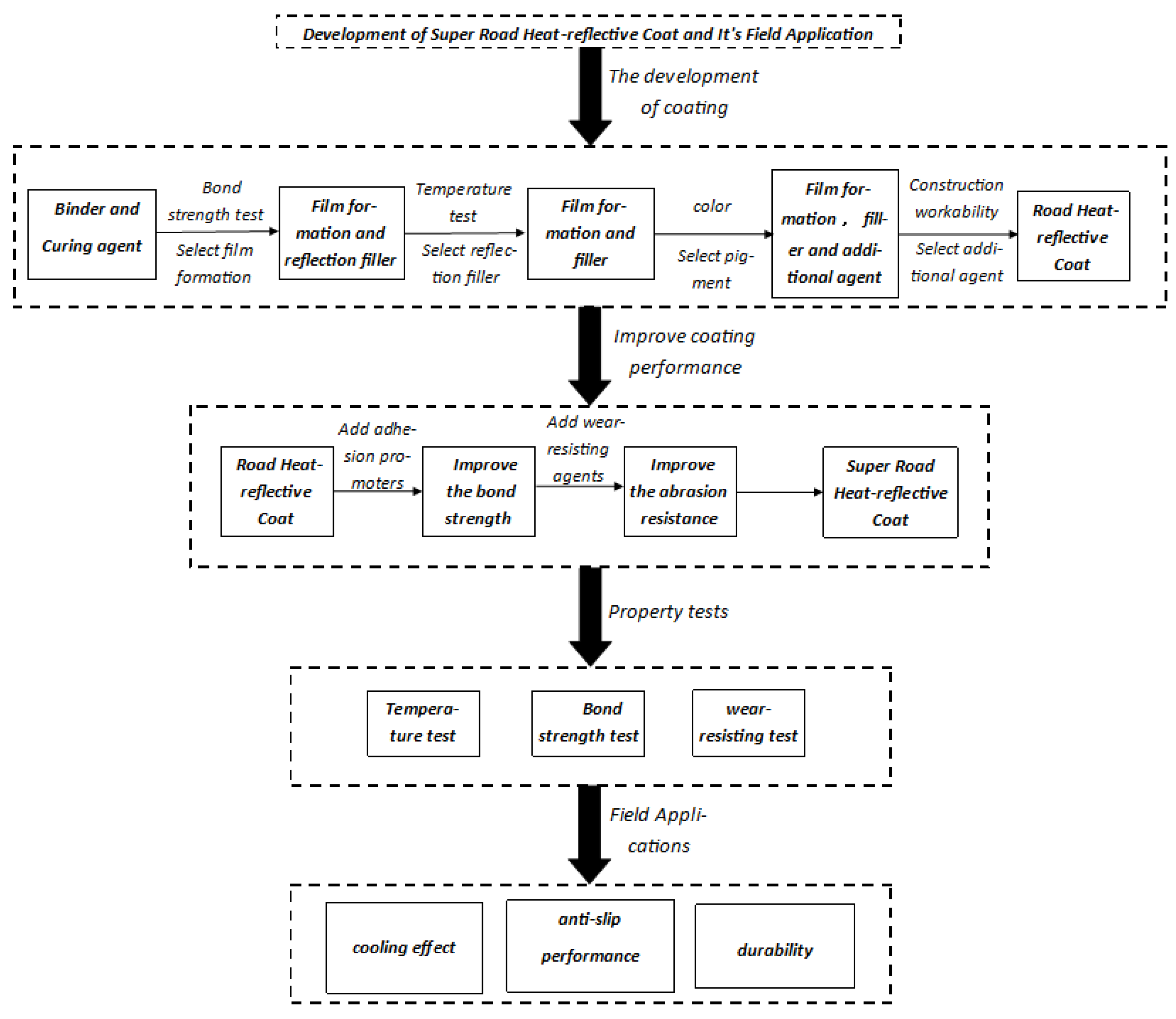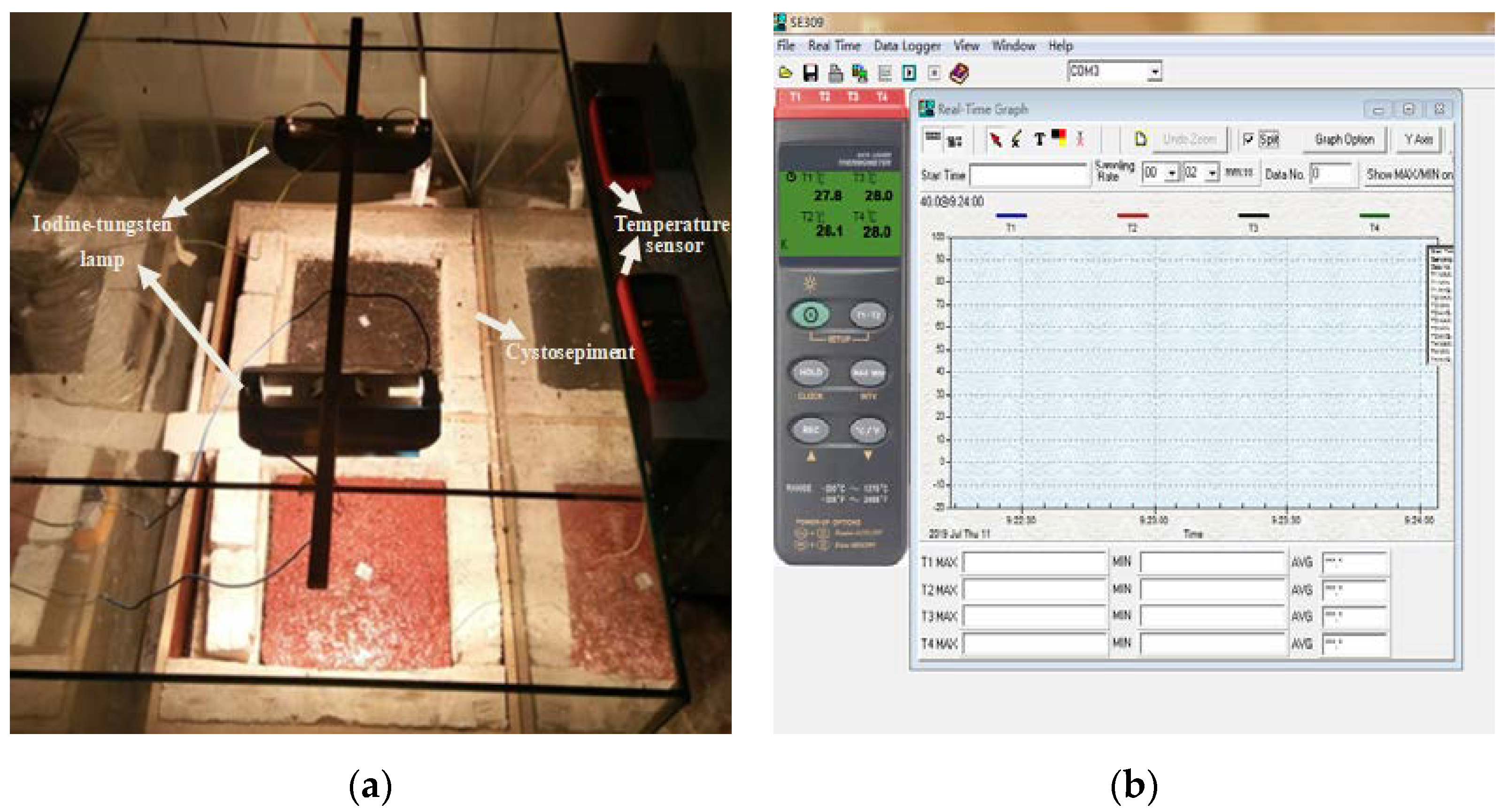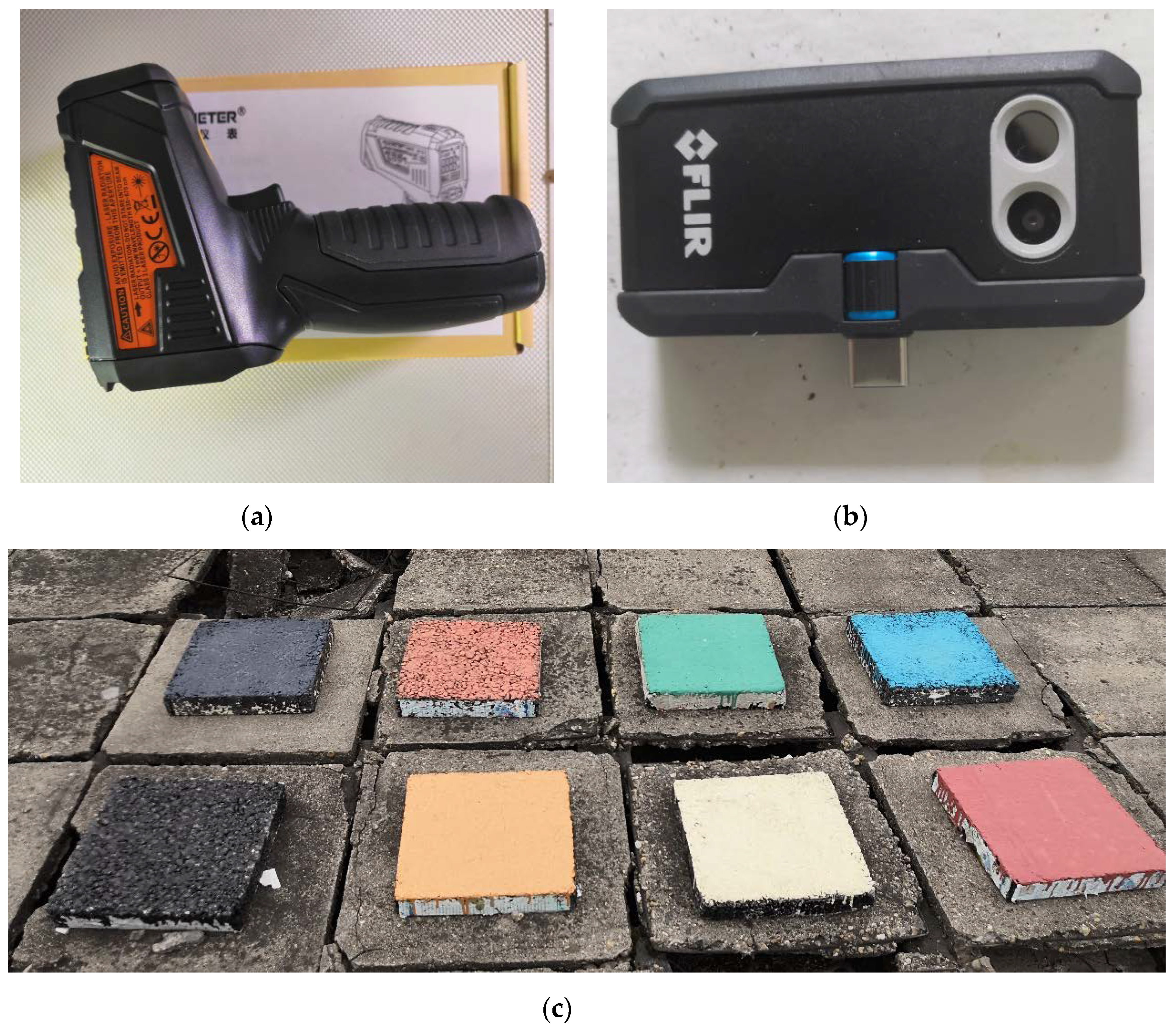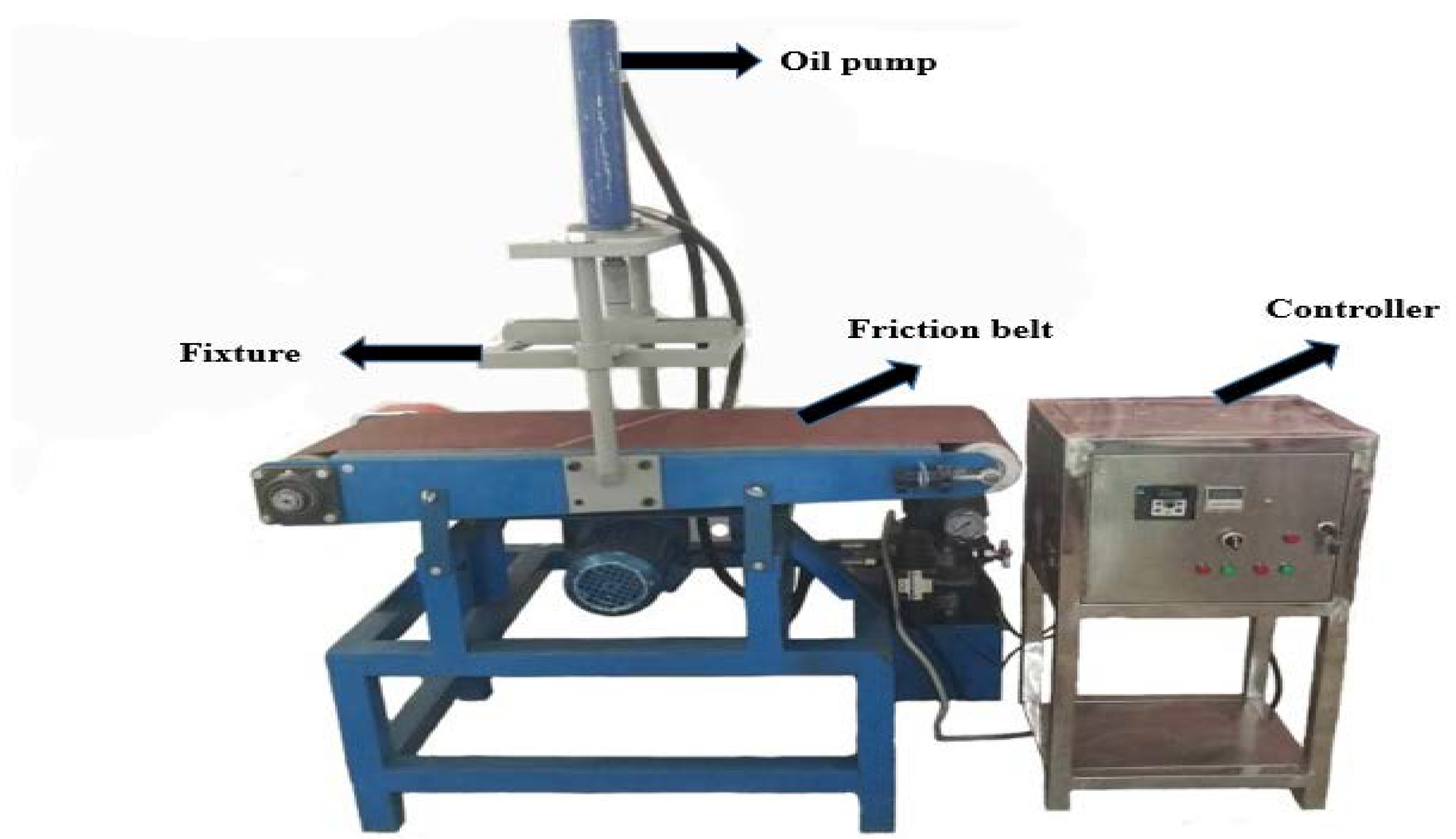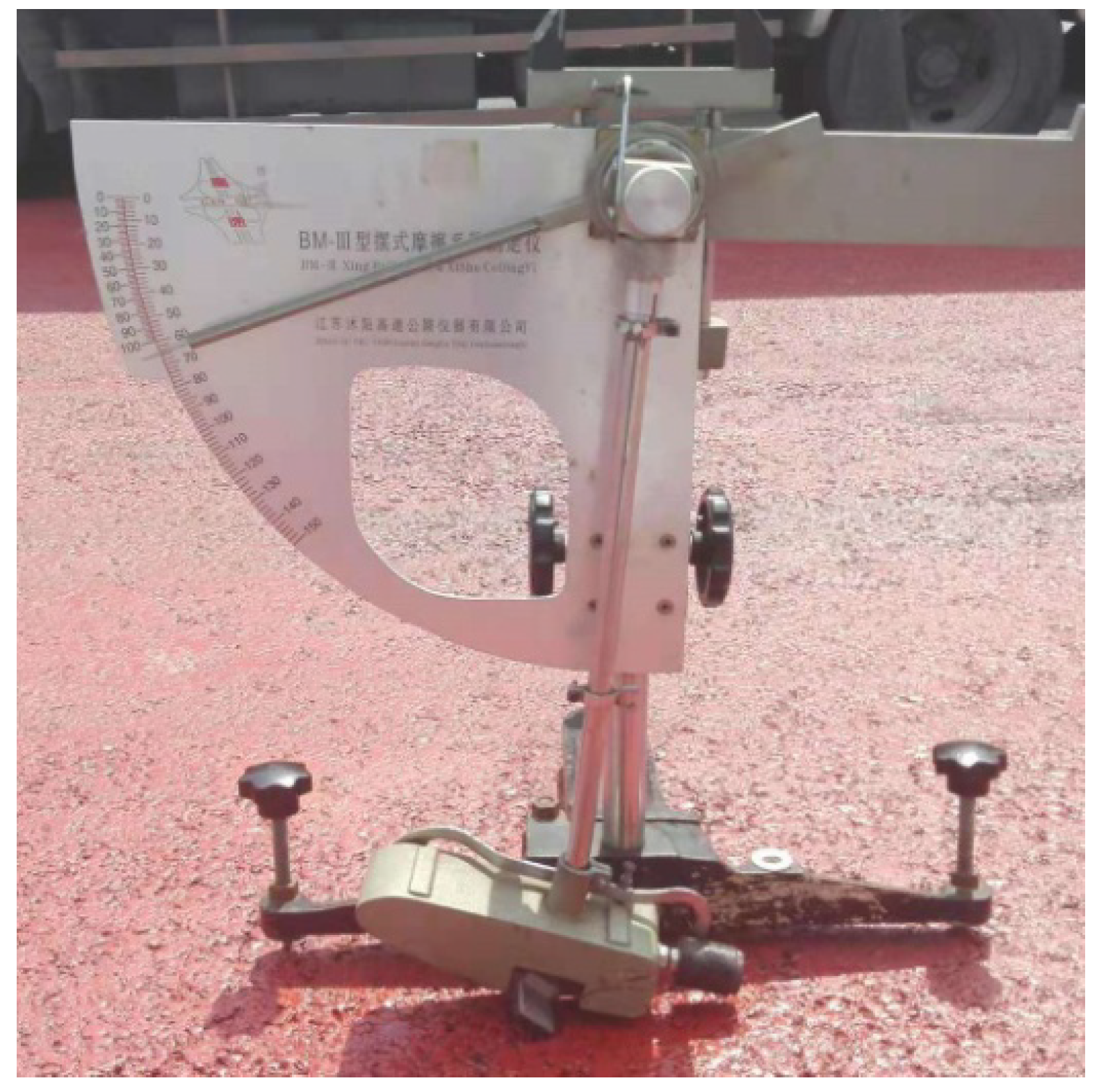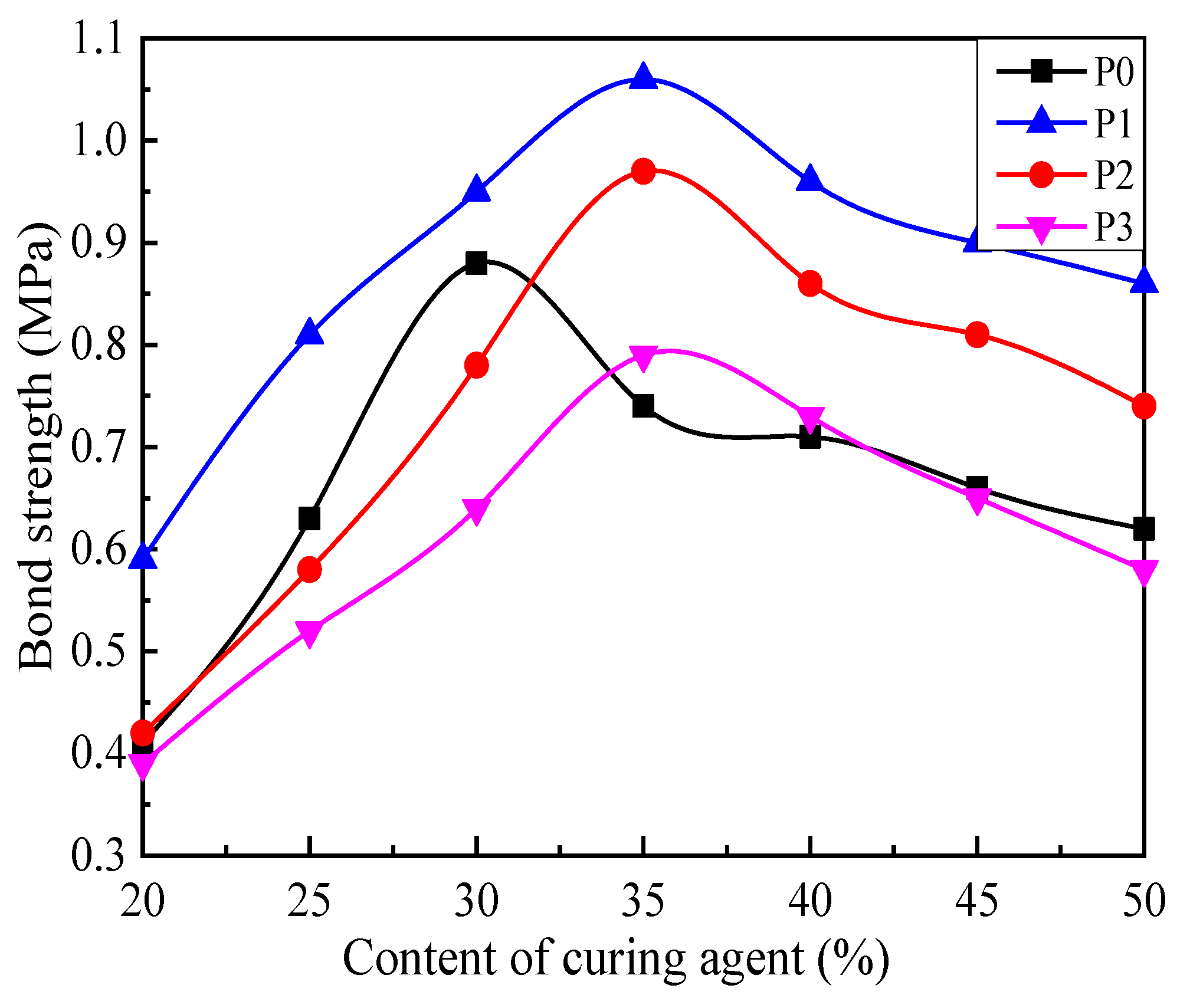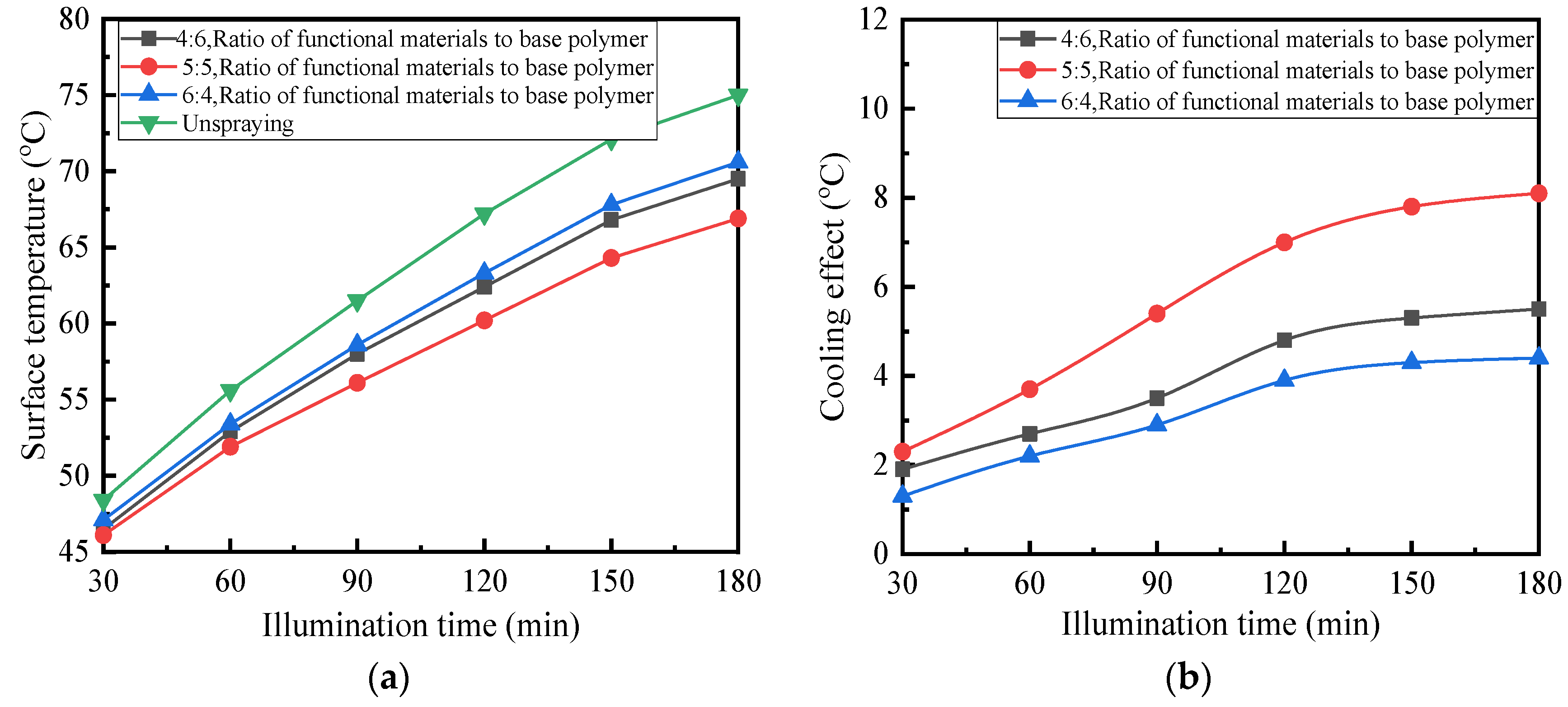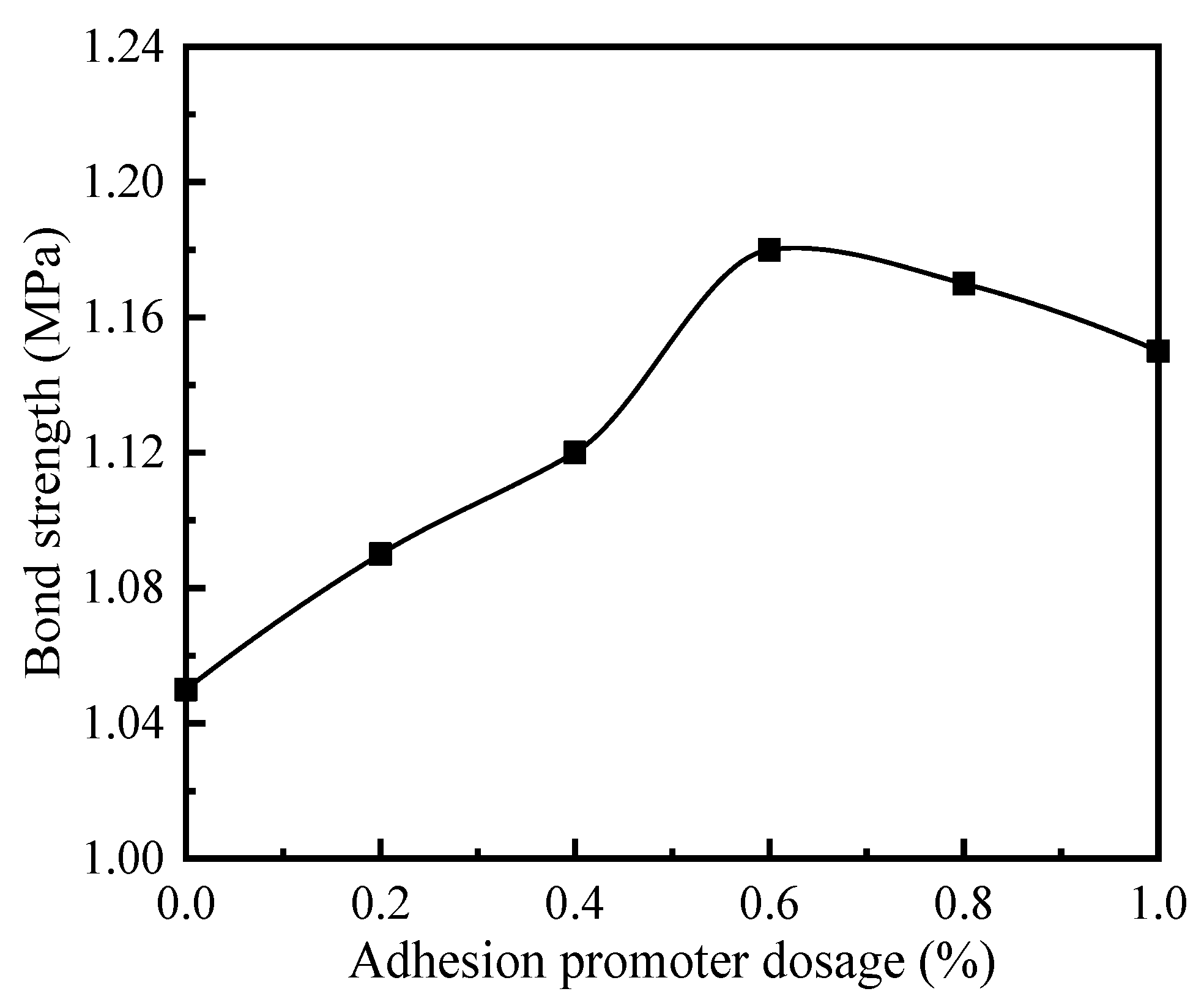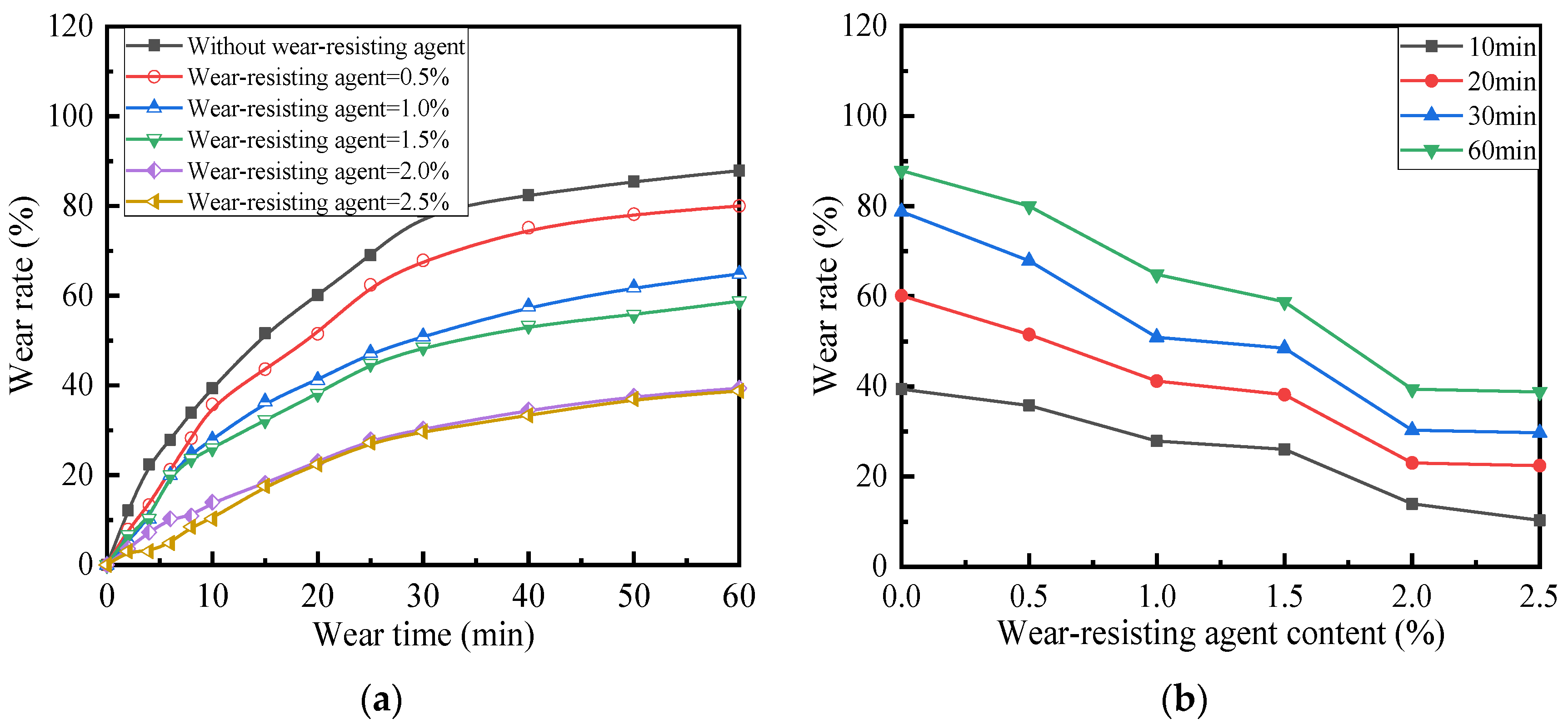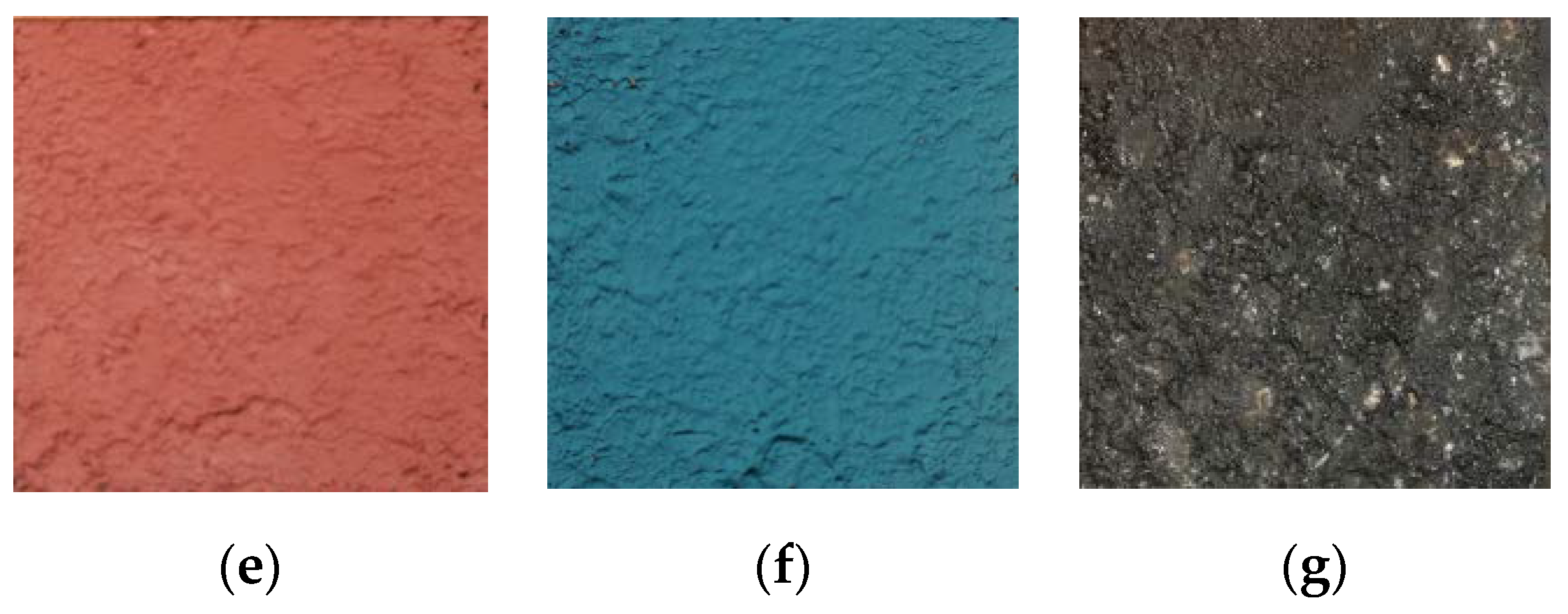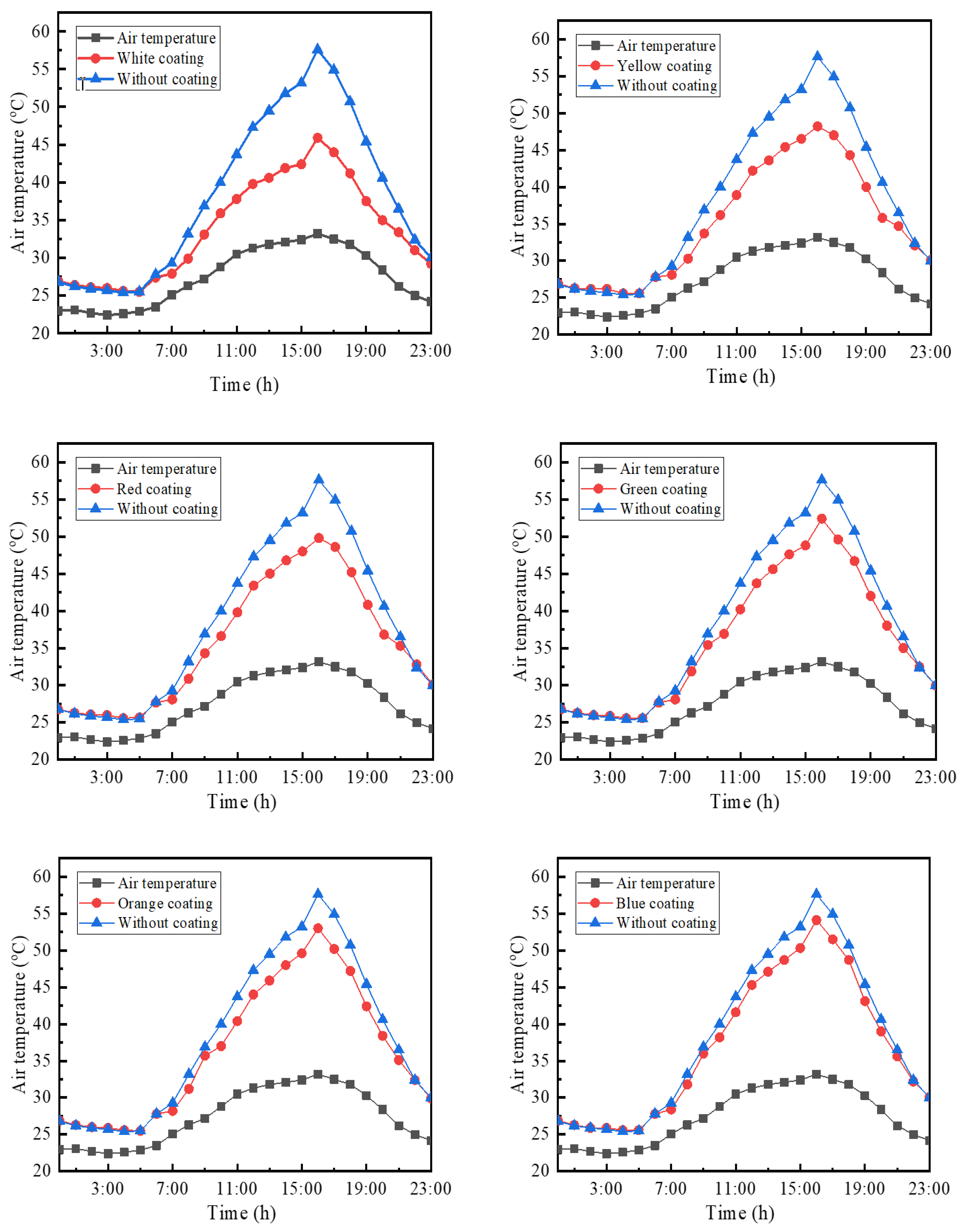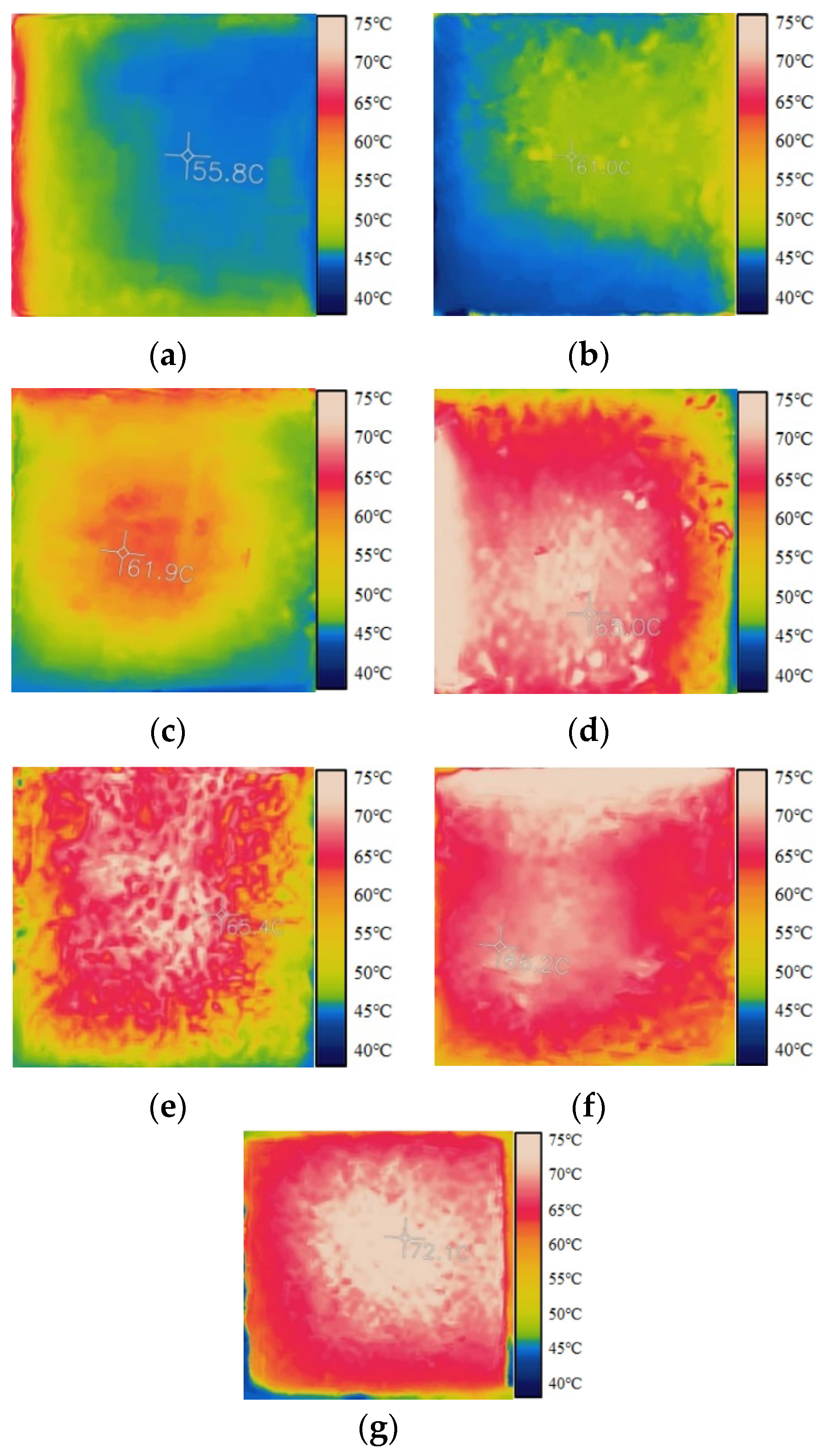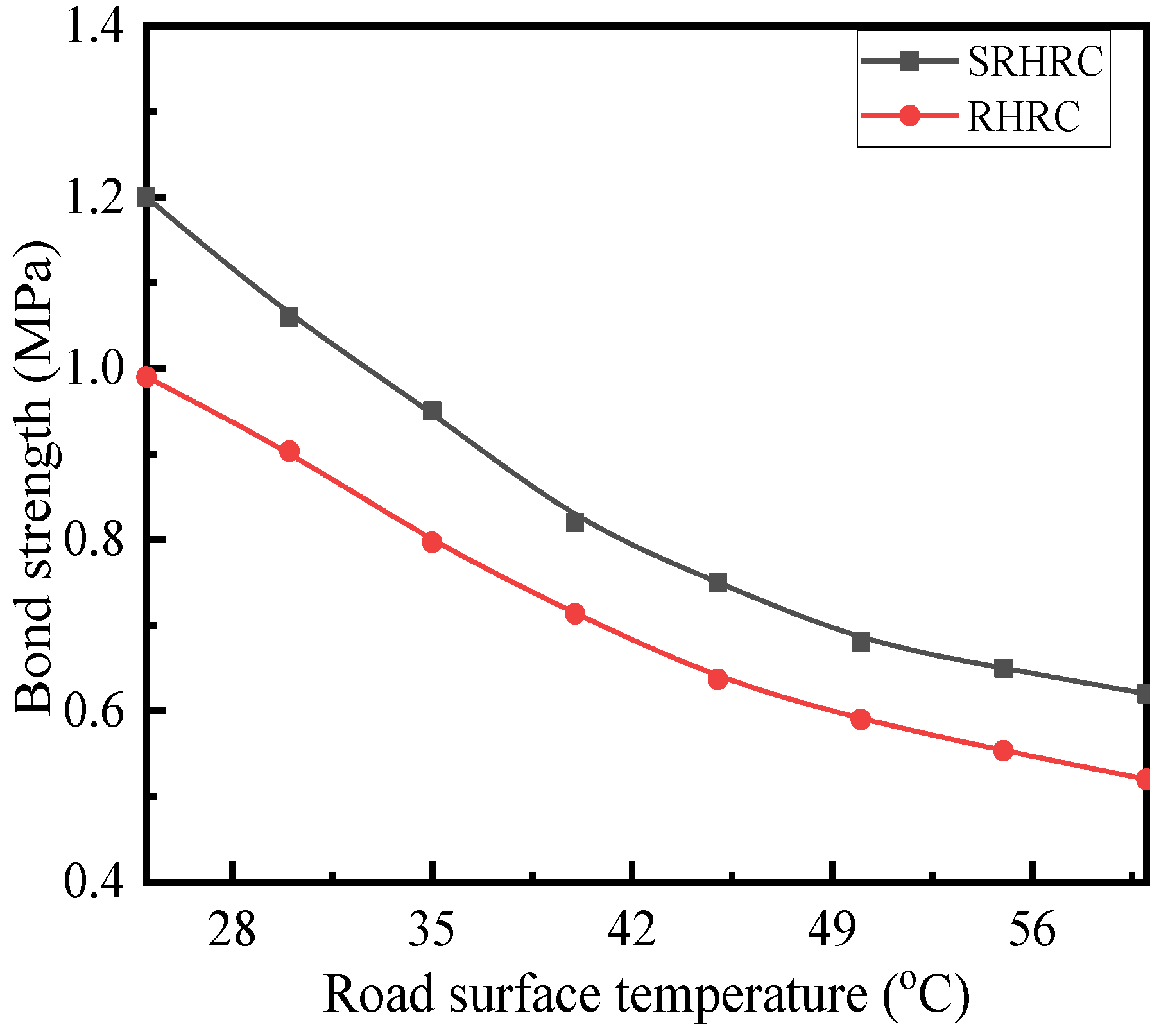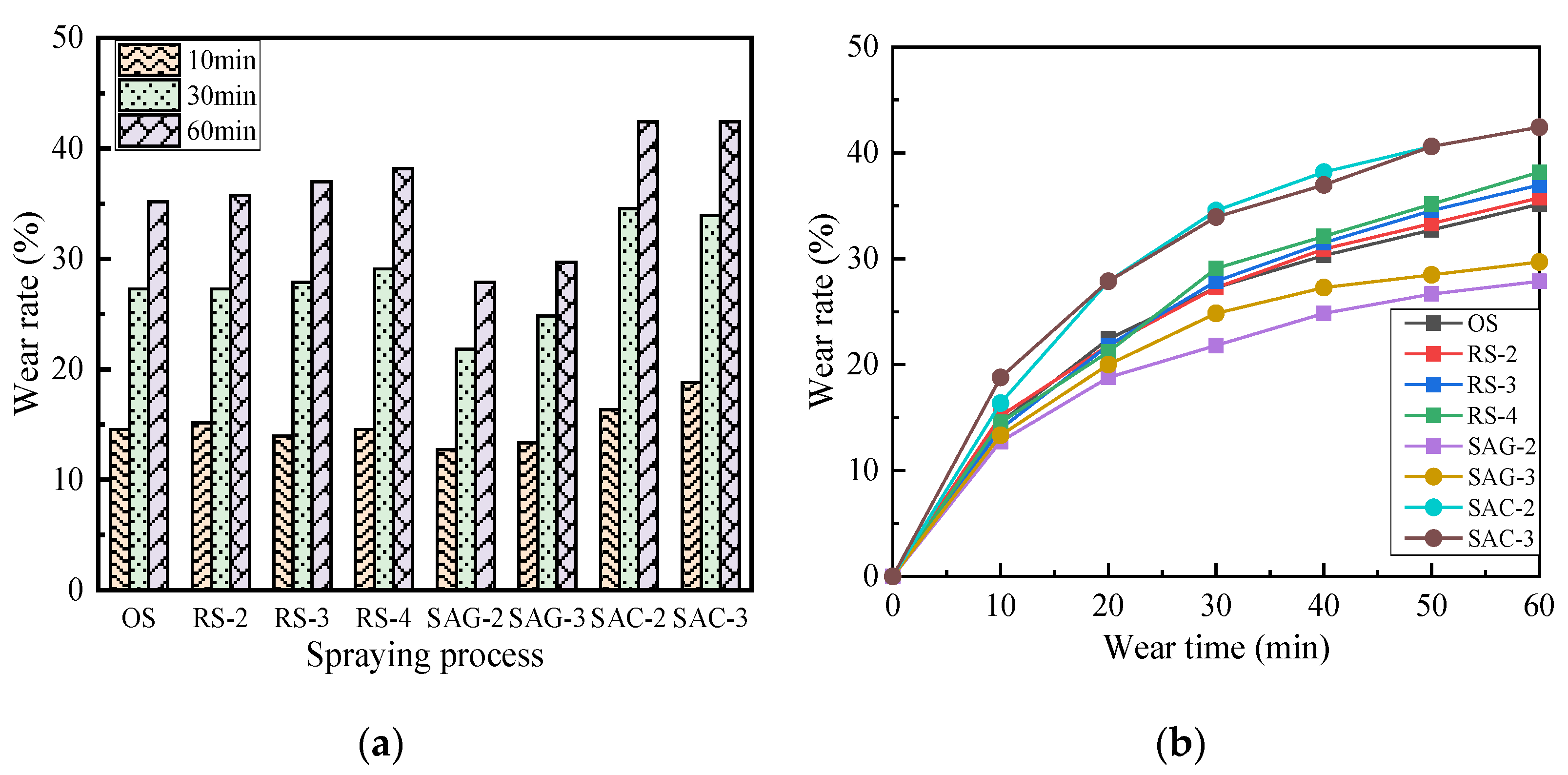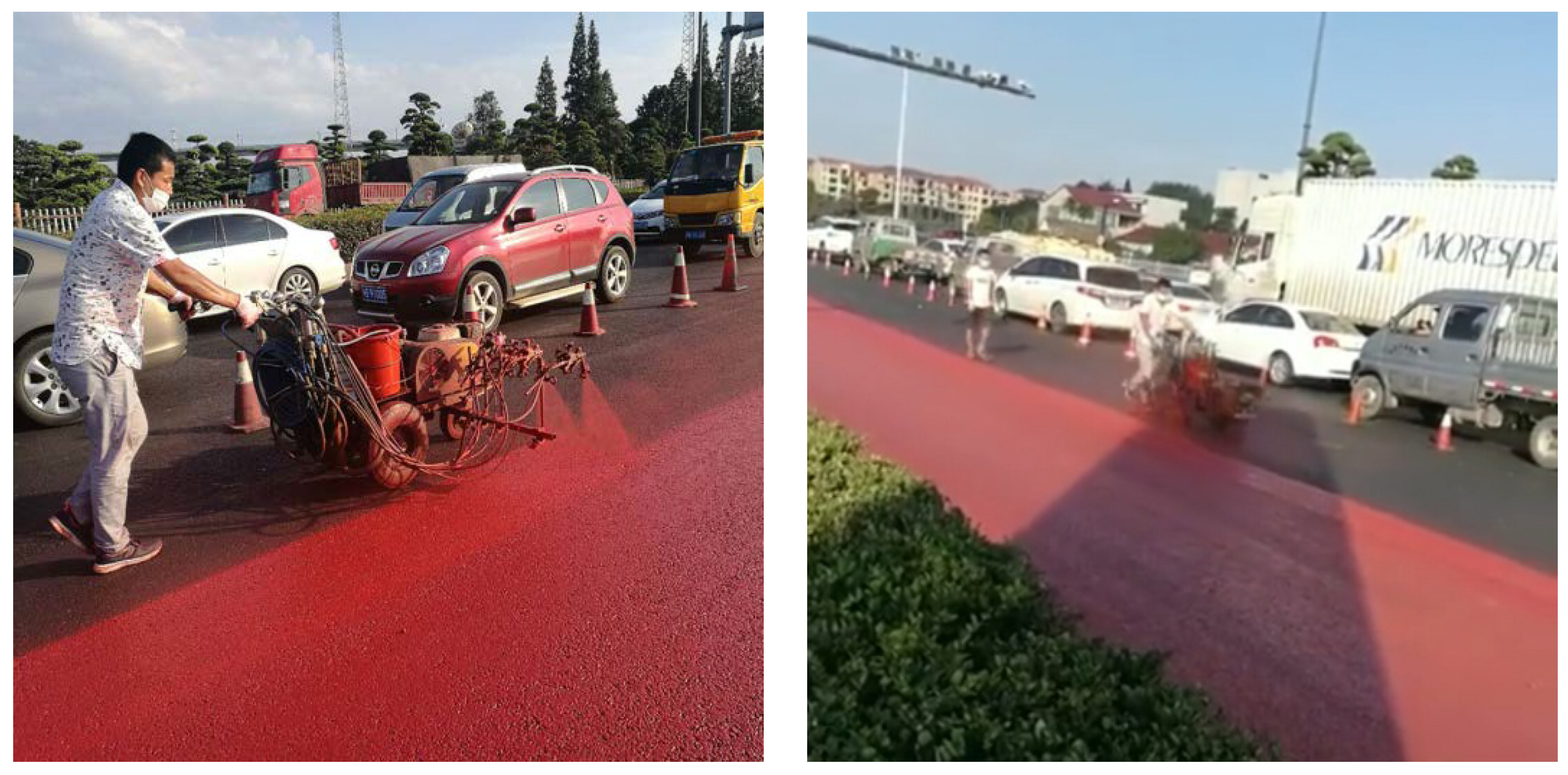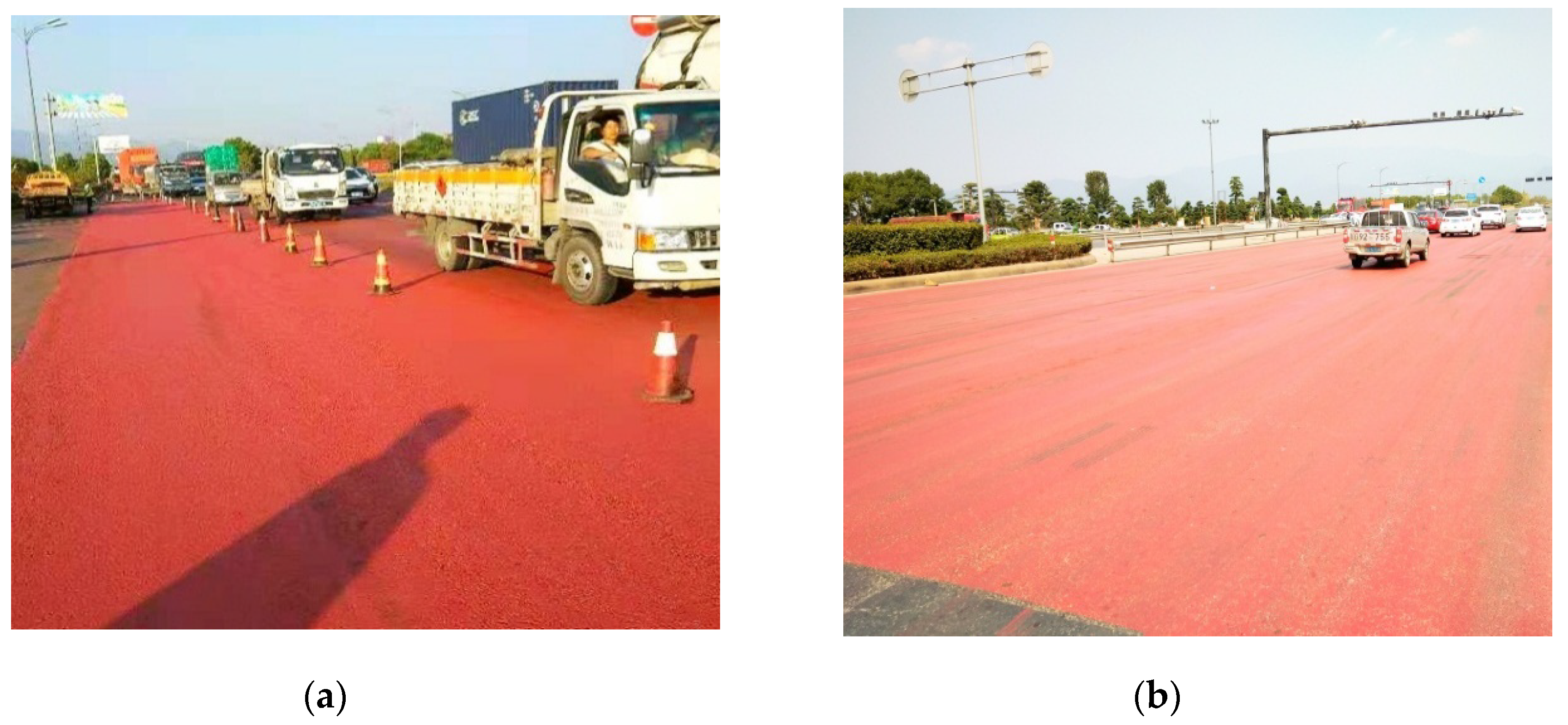1. Introduction
Big cities have significantly higher temperature than rural areas, both day and night: during the day, the heat reflection and emissions from buildings exacerbate the urban heat island effect [
1], while at night, the temperature increases due to the release of the heat stored in roads and buildings. The phenomenon of heat island effect increases year by year, consequently increasing the energy consumption and reducing the life quality and comfort of urban residents [
2,
3,
4,
5,
6]. The heat absorption rate of asphalt pavements is so high that their daytime temperature exceeds 60 °C and, thus, the ambient temperature of the road is also significant [
7]; the heat stored in the pavement is released at night, contributing to increasing the ambient temperature. In turn, the high temperature of the road surface is the main cause of rutting deformation [
8]. Therefore, reducing the heat absorption of asphalt pavements has become crucial for preventing the urban heat island effect and reducing the rutting deformation of roads [
9].
Coating an asphalt pavement with a heat-reflective layer can not only enhance the road surface’s ability to reflect solar radiation, and reduce both its temperature and rutting deformation but also decrease its heat storage and alleviate the urban heat island effect [
10,
11,
12,
13,
14,
15]. Heat-reflective coatings can have an excellent cooling effect, reduce the temperature of asphalt pavements by 8–16 °C during high-temperature periods in summer [
16,
17,
18,
19]. Cao et al. compared the internal temperature of asphalt and heat-reflective pavements; At 2.5 cm depth, the temperature of the traditional pavement reached 62.7 °C, while that of the heat-reflective one was reduced by 9 °C [
12]. Outdoor tests and experiments on test sections have also been conducted to further confirm the cooling effect of heat-reflective coatings [
7,
10,
20,
21]. Furthermore, Jiang et al. reported that heat-reflective pavements have better stability at high temperatures [
17,
22,
23]. This excellent cooling effect is one of the main reasons for the rapid development of heat-reflective coatings for asphalt pavements; in addition, the convenient construction and low cost of heat-reflective coating [
5] have made them one of the best solutions to rutting damage and heat island effect caused by asphalt pavements in summer [
4,
17,
22,
23].
Road researchers have studied not only the cooling effect of these coatings, but also the skid resistance, aging performance, permeability, microstructure, and abrasion resistance of the resulting heat-reflective pavements, as these coatings are applied to asphalt pavement surfaces. Cao et al. verified the reduced anti-skid performance of heat-reflective road surfaces [
7,
17,
23,
24,
25,
26], and reported that a controlled dosage of heat-reflective coating within 0.8 kg/m
2 can still satisfy the Technical Standards of the Chinese Technical Specifications for Construction of Highway Asphalt Pavements (JTG F40-2004) [
27]. Sha et al. demonstrated that inorganic materials can remain mostly stable under ultraviolet irradiation, while this condition would age the organic ones [
13,
23]. Cao et al. also tested the permeability of heat-reflective pavements, finding that they are basically impermeable because the coating almost seals their surface, preventing water from entering the concrete interior and, hence, avoiding asphalt and pavement damage [
12]. The microstructures of the heat-reflective coatings and their components have been investigated via scanning electron microscopy [
16,
18,
23,
26,
28,
29,
30,
31,
32]. Moreover, Hu et al. performed accelerated wear tests to study the wear performance of these coatings; the results showed quality loss after wearing, but an improved anti-skid granular stirring method could enhance the wear performance [
17,
24,
33].
The research on heat-reflective coatings is currently focused on their cooling effect and road performance. Previous research has showed that the developed heat-reflective coating not only can improve the road performance but also reduce the pavement temperature to some extent. However, the bond strength of coating has rarely been considered in road engineering. Moreover, the abrasion property of coating is rarely evaluated quantitatively in terms of quality loss and wear rate. Therefore, the bond strength and abrasion property were used as the control index to develop a durable coating. In addition, a coating abrasion meter of the abrasive heat-reflective coating was developed, which can test the quality loss and wear rate of coating. In this study, the influence of each coating component was comprehensively considered throughout the development process. In addition, the type and dosage of the film-forming material, functional filler, pigment, and auxiliary agent were selected based on four aspects: bond strength, cooling effect, color, and construction workability. Based on the bond strength and abrasion property to improve the durability of coating. Temperature tests, bond strength test and abrasion resistance test were carried out to verify the improved coating cooling effect, bond strength, and abrasion resistance. The heat-reflective pavement test section was paved, and the cooling effect, durability and anti-skid performance of heat-reflective pavement were tested.
3. Results and Discussion
Coating development, coating performance improvement and property tests are conducted and discussed in this section.
3.1. Coating Development
The RHFC development process included the selection of a film-forming material, fillers, and additives, as well as the dosage determination.
3.1.1. Film-Forming Material Selection
The mechanical strength of the film-forming materials determines the overall strength of the coating [
38]. Therefore, its selection should be based on this parameter. In this study, the bond strength was used as the index for choosing this component because heat-reflective coatings must have a good bond strength with the asphalt pavement, to avoid easy wear and peeling. Different contents of the curing agent (20%, 25%, 30%, 35%, 40%, 45%, and 50%) were added to the four base materials, respectively, and sprayed on the surface of asphalt mixture samples (with a spraying amount of 0.55 kg/m
2). The coating bond strength test was carried out as described in
Section 3.2.2 and the bond strength difference between the coating and asphalt mixture was used as the maximum damage strength.
Figure 7 displays the bond strength test results for these samples.
When using the P1 polyurethane-modified epoxy resin as the base material, the bond strength was the best and its maximum bond strength with the asphalt mixture, with the optimal curing agent content, was 1.05 MPa. The P2, P0, and P3 samples exhibited a maximum bond strength of 0.97, 0.88, and 0.76 MPa, respectively. The dosage of the curing agent was optimal (
Figure 7), namely, 35% for the P1, P2, and P3 samples and 30% for P0. Based on the principle of optimal bond strength, the sample formed with P1 polyurethane-modified epoxy resin and the curing agent dosage of 35% were selected.
3.1.2. Reflective Filler Selection
The functional filler comprises TiO
2 and SiO
2. High reflectivity guarantees the cooling effect of heat-reflective coatings; the higher the coating reflectivity, the better its cooling effect [
21,
39,
40]. Therefore, in this study, the functional filler content was optimized based on the resulting cooling effect. Based on previous research, both TiO
2 and SiO
2 were used as reflective filler and the ratio of the TiO
2 and SiO
2 is 2:1 [
17]. According to the procedure described in
Section 3.2.1, different functional filler/film-forming material ratios (4:6, 5:5, and 6:4) were tested for the temperature of the pavement heat-reflective coating and asphalt mixture samples. The test results are shown in
Figure 8.
After 180 min of simulated illumination, the surface temperature of the uncoated asphalt samples reached 75 °C. Under the same conditions, the maximum surface temperature of RHRC-1 with the functional filler was only 70.3 °C; the RHRC-1 formulation with the 5:5 functional filler/base material ratio showed the lowest surface temperature, i.e., 67 °C. The cooling effect of RHRC-1 gradually increased with the illumination time; the sample with the 5:5 functional filler/base material ratio exhibited the best cooling effect (up to 8 °C), followed by those with 4:6 (up to 5.5 °C) and 6:4 (only 4.7 °C) ratios. Based on these results, the optimal functional filler/base material ratio was identified as 5:5.
3.1.3. Pigment Selection
Pigments were added to adjust the coating color for different applications. The choice of the pigment content is positively correlated with its hiding power. Standard-color cards were used to select the coating colors; six types of heat-reflective coatings with different colors were prepared in the laboratory (
Table 7). The content of the fillings was 4.2%–6.8%.
3.1.4. Additional Agent Selection
Direct mixing and stirring of RHRC may result in insufficient construction workability due to, for example, air bubbles, filler precipitation, or insufficient fluidity. To improve the construction workability of the coatings, defoamers, dispersants, and leveling agents can be added and the specific mixing amount should be adjusted based on the real mixing conditions.
3.2. Coating Performance Improvement
When applied to asphalt pavements, commercial heat-reflective coatings are inevitably eroded under the traffic load due to wheel action. This probably occurs because traditional heat-reflective coatings are developed without considering their durability in this application environment. Therefore, in this study, after the RHRC development, the coating durability was improved based on the bond strength and abrasion resistance, and an SRHRC with better pavement performance was obtained.
3.2.1. Bond Strength Improvement
The adhesive strength of a coating indicates its adhesive performance with an asphalt mixture layer. A coating with high adhesive strength is not easy to peel off from the road surface, even if cracks form under the traffic load. Thus, increasing the adhesive strength, for example, by adding an adhesion promoter, can improve the coating durability and service life. Ordinary RHRC samples and RHRC formulations added with different contents of an adhesion promoter (0.2%, 0.4%, 0.6%, 0.8%, and 1.0%) were prepared.
Figure 9 shows the results of the test described in
Section 3.2.2 and conducted on these as-prepared samples.
The addition of 0.6% adhesion promoter improved the adhesive strength of the coating by 12.4%, but higher contents reduced the coating adhesion performance. The adhesion promoter is a silane-coupling agent; therefore, when it is placed between inorganic and organic interfaces, an organic matrix/silane-coupling agent/inorganic matrix bonding layer can be formed to improve the coating adhesion. However, excessive content of the adhesion promoter can lead to coating that is too brittle, and prone to brittle fracture, reducing the overall bond strength. Therefore, the optimal adhesion promoter content was identified as 0.6%.
3.2.2. Abrasion Resistance Improvement
The abrasion property of heat-reflective coatings indicates their ability to resist the friction action of the traffic load on the asphalt pavement; it is an intuitive expression to predict their service life. The abrasion properties of RHRC-1 samples, pure and added with different amounts of a wear-resistant agent (0.5%, 1.0%, 1.5%, 2.0%, and 2.5%), were tested as described in
Section 2.3.2. The results are shown in
Figure 10.
The wear time simulates the service life of a heat-reflective coating under vehicle friction. With its increase, the coating wear rate and service life increase, but all properties of the remaining coating decrease. For wear times of 0–5, 5–10, 10–25, and 25–30 min, the wear rate of the coating increased, respectively, very fast, fast, slowly, and slowly. This is attributable to the fact that the initial coating thickness was large, the same abrasion condition could wear away more quality coating, and as the coating was worn, the exposed stone basically could not be worn, so the wear rate growth slowed down.
With an increase in the wear-resistant agent as a type of coating resistant to abrasion ability,
Figure 10b shows that the mixing with this agent decreased the rate of coating abrasion, at 30 min abrasion ratio, as the evaluation index of coating abrasion ability; without the wear-resisting agent, the abrasion rate was as high as 79%, while the wear-resisting agent contents of 0.5%, 1.0%, 1.5%, 2.0%, and 2.5% resulted in abrasion rates of, respectively, 62%, 53%, 40%, 30%, and 29%. Under the dual control of performance and control cost, the optimal content of the wear-resistant agent was identified as 2.0%.
3.3. Property Tests
SRHRC, a coating with good durability and cooling performance, was obtained by improving the bond strength and abrasion resistance of RHRC. To evaluate its cooling effect, durability, and other road performance and to verify its applicability on asphalt pavements, tests on outdoor temperature, bond strength, abrasion resistance, and slip resistance were conducted.
3.3.1. Super Road Heat-Reflective Coating (SRHRC) Cooling Effect
The cooling effect of SRHRC was investigated via outdoor temperature tests performed between 4 and 16 August. The molded SRHRC-1 samples of white, yellow, red, green, orange, blue, and asphalt mixtures were placed outdoors (
Figure 11); the surface temperatures of the samples were recorded by an infrared detection gun and the corresponding thermal images were generated with infrared imaging devices.
Table 8 shows the daily surface temperature measured at the maximum air temperature, revealing a proportionality between these two parameters. This might have occurred because the temperature is directly proportional to the solar radiation intensity, which also determines the sample temperature [
5]; however, this can also be affected by wind, rain, and other factors [
1]. The air and sample surface temperatures measured on 10 August in the outdoor test are shown in
Figure 12, clearly revealing the effect of color on the cooling effect, in the following order: white > yellow > red > green > orange > blue. The white coating, with the best cooling effect, reduced the sample surface temperature by 11.7 °C at the maximum air temperature; under the same condition, the blue coating decreased the surface temperature by only 3.5 °C. This may be because a white coating reflects all colors of light, while those of other colors reflect preferentially the corresponding color. Reflectivity is the key factor determining the cooling effect of a coating [
18,
29]. The white and yellow coatings exhibited the best cooling effect, but a too strong glare on the actual road surfaces, which may affect the driver safety. Therefore, the red coating is recommended. The thermal image of the sample surface recorded on 15 August (
Figure 13) further demonstrates the influence of the coating color on its cooling effect.
3.3.2. SRHRC Bond Strength
The bond strengths of RHRC and SRHRC at different temperatures were compared (
Figure 14). At 25 °C, SRHRC reached a bond strength of 1.20 MPa, about 20% higher than that of RHRC. The increasing temperature decreased the bond strength difference between RHRC and SRHRC. This is attributable to the asphalt softening caused by the rising temperature, which reduced the bond strength between the coating and asphalt mixture. This result indicates that when the temperature of the asphalt pavement is high, the coating is easy to peel and undergoes other forms of damage.
3.3.3. SRHRC Abrasion Resistance
The samples that underwent one spraying, multiple sprayings, multiple sprayings and successive coating with a gel layer, and multiple sprayings after curing were named as OS, RS-X, SAG-X, and SAC-X (X = spraying times), respectively. Eight groups of samples were obtained via these different spraying methods and used for wear tests. The results are shown in
Figure 15.
The wear resistance of the coating is related to the spraying method but not the spraying time; choosing a suitable spraying method can significantly improve the wear resistance of the coating, while optimizing the spraying time has little effect on it. However, increasing the spraying time can improve the coating uniformity. The SAG-X and SAC-X samples were, respectively, the most favorable and most unfavorable to enhance the coating wear resistance; this may be because curing and spraying the next layer will appear to make two layers of coating adhesion insufficient and it will be worn off. The difference between multiple sprayings and single spraying was small. The wear rate of the coating sprayed with SAG-3 after wearing of 60 min is less than 30%. It is suggested the coating is sprayed with SAG-3, which is good not only for the wear resistance but also for spraying uniformity.
4. Field Applications
To verify the reliability of the abovementioned theoretical analysis and test results, a heat-reflective coating test section was paved in Jinhua, Zhejiang province, China and the SRHRC-1 applicability and road performance were verified in combination with physical engineering and laboratory tests.
4.1. Project Profile
The test section was located at the junction between the West Erhuanxi road and the Gold Orchid center line, in the Wucheng District, Jinhua City Circle, and the provincial road intersection, west on the outer ring of the Wucheng District. Large numbers of heavy vehicles, long-term congestion, deep pavement rut deformation, and a large number of diseases, such as network cracks, affect not only driving comfort but also traffic safety.
4.2. Construction Technology and Process
The on-site construction of the color heat-reflective coating in the test section followed these steps: blocking the traffic, cleaning the road surface from dust (soil), applying adhesive tape marks, treating the road grid, coating spraying (
Figure 16) and curing, and health preservation. The test section was re-opened to traffic after the color coating was fully solidified (2 h) and reached a certain strength.
4.3. Effect of Inspection
After the preparation of the test section was completed, monitoring of the performance (i.e., cooling effect, anti-skid performance (
Table 9), and durability (
Figure 17)) of the heat-reflective pavement was initiated.
Table 10 shows the maximum and average temperatures of asphalt pavement and heat-reflective pavement measured using the infrared temperature gun with once an hour.
SRHRC could reduce the asphalt surface temperature by 7.0 °C when this reached 65.7 °C. On the other hand, it also reduced the anti-skid performance of the road surface; nonetheless, the reduction was small, and hence, the resulting anti-skid performance could still meet driving safety requirements. After being opened to traffic, SRHRC-1 showed good durability, ensuring its normal use for 4 months.
